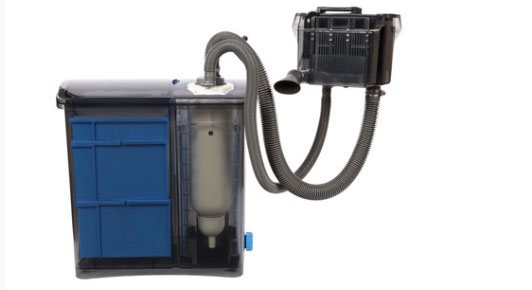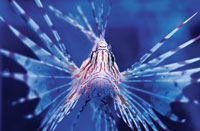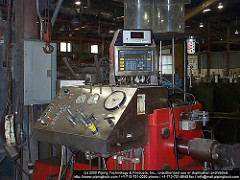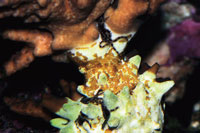
Q. The other night my mustang male gave birth to at least 300 babies. In the morning there were less than 50 in the tank. What do you think happened to them? Did they die or did the parents eat them?
Jules
A. More than likely the seahorse babies got sucked up into the filter and died sometime during the night. In the ocean, when seahorse babies are born, they float to the surface and drift in the surface currents hoping to drift into food, such as copepods. In captivity, it is the same.
So, in your home aquarium the fry will float to the surface and go wherever the current carries them. Unfortunately, they usually float right to the filtration unit and turn into mush. This is probably why you counted so few fry in the morning. If you want to avoid this, it is best to remove the fry from the parent tank as soon as you see them.
Here at Ocean Rider we have more than five males giving birth every day. We are lucky enough to actually witness the birthing event, which is magnificent. We also get to see what happens to the babies afterwards. What we see is exactly what is supposed to happen.
The babies float to the surface, interlock their tales and drift in the surface currents. After a few hours they will begin to orient toward the light (a positively phototaxic behavior). They look for food and are capable of eating immediately. We have never seen the parents eat the babies.
Just the other day, about 20 visitors and myself gathered around one of our large display tanks that is about 8 feet in diameter and 4 feet deep. We were all lucky enough to witness a large 6-year-old male give birth to more than 600 babies. He was in a tank with more than 100 adult seahorses. As soon as the male gave birth all the other seahorses swam as fast as they could to the babies — to investigate the newborns. Now, the newborns were on the surface, so the adults all swam up to see them. Imagine, 100 adult seahorses swarming on 600 baby seahorses. It was incredible to watch!
Everyone thought the adults were racing to eat the babies, but as soon as they got about 1 inch away from the babies they put their brakes on and came to a complete stop. They looked at the babies, as if they realized for the first time that the babies were not food. The adults then turned around and swam right back down to the bottom of the tank and to their hitching posts. Not one adult Hippocampus erectus ate or even taste tested any baby seahorses. It was incredible and certainly answered the question about whether or not adult seahorses eat their babies, at least with this species.
Now, if someone has witnessed their H. erectus seahorse eating babies, I would guess that it was a single occurrence and a mistake made by the parent rather than an intentional act.
Are They Cannibals?
Q. Once and for all: Do seahorses eat their fry? I have never witnessed any of my horses even attempting to eat fry. I have heard many professionals, including you, Pete, state seahorses don’t eat their babies.
Recently, while in an online chatroom, I was in the middle of a huge online discussion, and some of these people have been breeding for years and swear they have personally witnessed this take place. I have only had a few batches of fry, and at no time have I witnessed any fry being eaten. I did have some disappearances, but I blamed them on the scavengers, such as crabs, peppermint shrimp and, of course, the most obvious, the filter.
These people in the chatroom claim to have watched erectus (mostly) hunt down and eat fry. Pete, I think if anyone would know for sure you would. So what is the verdict?
Cindy
A. Cannibalism in seahorses is very uncommon. It does occasionally occur among seahorses with pelagic fry, but such episodes are normally rare exceptions. Hippocampus erectus is not typically known for this, but cannibalism does take place in very isolated incidents. I have never personally witnessed a case of cannibalism in H. erectus. Hippocampus erectus fry undergo an abbreviated pelagic phase and every once in a while there are reports of cannibalism, but 99 percent of the time erectus make model parents.
However, some species are more prone to this aberrant behavior than others. For example, unlike most seahorses, captive-bred H. abdominalis are confirmed cannibals under certain circumstances. This unusual behavior doesn’t appear to be a consequence of dietary deficiencies or overcrowding.
It seems to be due to the simple fact that cultured “pots” are accustomed to being fed. Rather than hunting for live prey along the bottom, they expect their prey to be introduced from the surface and come down to them. They are thus conditioned to take anything above them in the water column within the right size range that drifts past, and this includes surface-hugging pelagic fry.
As a case in point, David Warland experienced cannibalism of fry by young potbelly adults 18 to 24 months old and maintained at a stocking density of 30 seahorses per 800 liters (211 gallons). Because that’s one seahorse for every 26.6 liters (7 gallons), he does not believe overstocking was a factor in the cannibalism, nor did hunger play a role as the H. abdominalis were fed to capacity four to five times daily during daylight hours (sunup to sundown).
Surprisingly, when cannibalism does occur, it is often the female that’s the culprit. That is the case with H. comes, one of the few seahorses species that is known to cannibalize its young on occasion (Neil Garrick-Maidment, pers. comm.). When this happens with tigertails, it is typically the accompanying female that begins predating the fry as her mate gives birth (Lesley Holland, pers. comm.).
The male may then follow suit as well and the entire brood can quickly be destroyed (Lesley Holland, pers. comm.). Once a pair of tigertails turns cannibal, this unnatural behavior is likely to become habitual, putting their future offspring at risk.
In all my years, I have only once heard a report of any such problems from seahorses with benthic fry, and in that case it was the least likely culprits you could imagine that were at fault — female dwarf seahorses (H. zosterae). Now, cannibalism is, of course, unknown in H. zosterae, as the adult dwarfs are much too small to swallow even newborn fry, but apparently infanticide is not. This is what Joanne Heuter, a very accomplished breeder of dwarf seahorses, reports in that regard:
“The adult females will sometimes kill the newborns by snapping the back of their necks with their heads. I don’t know why, maybe competition for food, your guess is as good as mine. This is the only act of aggression I have ever noted in the dwarf seahorses. I keep the babies away from the main tank for at least three weeks after birth.”
Cannibalism is quite rare in seahorses. There are a few species, such as H. abdominalis and H. comes, that seem to be more predisposed to cannibalism. Seahorsekeepers, potbelly and tigertail breeders in particular, should simply be aware that cannibalism could occur and be on guard lest it becomes a problem.
When it comes to your mustangs and sunbursts, cannibalism is an extreme rarity. So if you have a pregnant male and are expecting a brood shortly, don’t worry — when the big moment arrives, the odds are overwhelmingly in your favor that Mr. Mom will be a regular Dr. Spock when it comes to his offspring, not a Hannibal Lector!
 Aquarium Filtration Done Right
Today, keeping unique aquatic species is now commonplace tha
Aquarium Filtration Done Right
Today, keeping unique aquatic species is now commonplace tha
 Invasive Aquatic Species
Last column, we discussed invasive species and the potentia
Invasive Aquatic Species
Last column, we discussed invasive species and the potentia
 Would You Like The Supreme Fishing Experience? Heres The Reason Why It Is Essential To Carry The Mo
If what youre seeking out is considerably more fish thr
Would You Like The Supreme Fishing Experience? Heres The Reason Why It Is Essential To Carry The Mo
If what youre seeking out is considerably more fish thr
 Red Worms
Q. I’ve seen advertisements for red worms as a food for fish
Red Worms
Q. I’ve seen advertisements for red worms as a food for fish
 Coral and Invertebrate Quarantine Procedures
Coral and Invertebrate Quarantine Procedures
Copyright © 2005-2016 Pet Information All Rights Reserved
Contact us: www162date@outlook.com